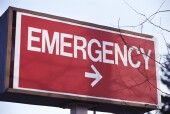September 19, 2014

 By Alan MozesHealthDay Reporter
By Alan MozesHealthDay Reporter
Latest MedicineNet News
THURSDAY, Sept. 18, 2014 (HealthDay News) — When it comes to emergency room waiting times, patients seeking care at larger urban hospitals are likely to spend more time staring down the clock than those seen at smaller or more rural facilities, new research suggests.
“The experience of crowding and our ability to provide timely emergency care varies dramatically across hospitals in the United States,” said one of the authors of the new research, Dr. Renee Hsia, an associate professor at the University of California, San Francisco.
“All things being equal, hospitals with longer wait times or lengths of stay tended to be large, urban, publicly owned hospitals that took care of a high proportion of Medicaid patients,” said Hsia, who’s also an attending physician and director of health policy studies in the department of emergency medicine at San Francisco General Hospital.
The findings are from two research letters in the Sept. 15 issue of JAMA Internal Medicine.
In the first study, Hsia and co-author Sidney Le — a UCSF medical student — focused on medical records concerning adult patients seen at almost 3,700 different emergency rooms across the country in 2012 and 2013.
Nearly three-quarters of the ERs were in non-teaching hospitals. Almost two-thirds of the ERs were at private non-profit facilities. And, slightly more than half were located in an urban setting.
Patients who were not ultimately admitted waited an average of a half-hour to see a health care professional. And, overall, they spent a little more than two hours in the ER, the study found.
On the other hand, admitted patients spent an average of four hours in the ER. About one-third of that time occurred after admission but before an in-patient bed became available.
The investigators also found that ER patients seen and discharged at a large and/or urban hospital ended up waiting longer to see someone (and spent more time overall in the ER) than those at smaller and/or rural facilities. And among admitted patients, those seen at either a public hospital or a major teaching hospital tended to be in the ER notably longer than those admitted to other types of care centers.
In the second analysis, Hsia and colleagues examined data from nearly 25,000 ER visits. The data had been collected by the 2010 National Hospital Ambulatory Medical Care Survey.
Hsia’s team found that just over half of the ERs were able to get 90 percent of patients who needed to be admitted in and out of the ER within an 8-hour period. But, less than a quarter of ERs were able to get 90 percent of their non-admitted patients discharged within a 4-hour period.
The researchers cautioned that efforts to pressure ERs to perform better need to recognize that not all patients are alike, with some needing greater and lengthier emergency care than others.
“Emergency department patients require varied services,” they wrote, “and a [length of stay] that is adequate for one patient may be insufficient for the evaluation of another.”
Along the same lines, Hsia noted that well-meaning policies intending to push ERs to shorten their waiting times “may have unintended consequences,” perhaps even encouraging the unnecessary admission of patients who might be better off being discharged.
Dr. Jeremiah Schuur, author of an accompanying editorial in the same issue of the journal, seconded Hsia’s concerns.
“It’s certainly important to publicize this issue,” said Schuur, who is an assistant professor of emergency medicine with Harvard Medical School.
“Medicare started advertising waiting times at ERs about a year ago. And that will be a strong incentive for hospitals to work on and improve their waiting times,” he added.
“But in terms of other types of incentives, I’m not sure that tying performance to say payments, for example, is a good move. Because some of the hospitals with longer waiting times, like teaching hospitals, care for the most complex patients who often don’t have access to regular care. And these places are, by nature and necessity, going to have longer waiting times,” warned Schuur, who is also chief of the division of health policy translation in the department of emergency medicine at Brigham and Women’s Hospital in Boston.
“And for concerned patients it’s also important to note that waiting times shouldn’t be the only determining factor in terms of where one seeks emergency care,” he said.
“For one, seeking out the closest facility is usually the right thing to do. And for trauma and chest pain patients calling the EMS system is the right way to access emergency care. And in those cases, the patients may not actually have a choice as to what facility they go to,” he explained.
 Copyright © 2014 HealthDay. All rights reserved.
Copyright © 2014 HealthDay. All rights reserved.
SOURCES: Renee Hsia, M.D., M.Sc., associate professor, University of California, San Francisco, and attending physician/director of health policy studies, department of emergency medicine, San Francisco General Hospital; Jeremiah D. Schuur, M.D., M.H.S., assistant professor, emergency medicine, Harvard Medical School, and chief, division of health policy, department of emergency medicine, Brigham and Women’s Hospital, Boston; Sept. 15, 2014, JAMA Internal Medicine, online
![]()